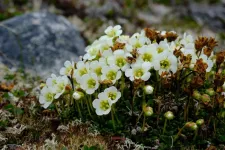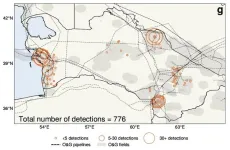(Press-News.org) A large find of dinosaur tracks and fossilized plants and tree stumps in far northwestern Alaska provides new information about the climate and movement of animals near the time when they began traveling between the Asian and North American continents roughly 100 million years ago.
The findings by an international team of scientists led by paleontologist Anthony Fiorillo were published Jan. 30 in the journal Geosciences. Fiorillo researched in Alaska while at Southern Methodist University. He is now executive director of the New Mexico Museum of Natural History and Science.
University of Alaska Fairbanks geology professor Paul McCarthy, with the UAF Geophysical Institute and UAF College of Natural Science and Mathematics, was a leading contributor to the research. He and UAF graduate student Eric Orphys are among the eight co-authors.
Fiorillo and McCarthy are longtime collaborators.
“We've had projects for the last 20 years in Alaska trying to integrate sedimentology, dinosaur paleontology and the paleoclimate indicators,” McCarthy said. “We’ve done work in three other formations — in Denali, on the North Slope and in Southwest Alaska — and they're about 70 million years old.”
“This new one is in a formation that's about 90 to 100 million years old,” he said.
Fiorillo said the additional age is notable.
"What interested us about looking at rocks of this age is this is roughly the time that people think of as the beginning of the Bering Land Bridge — the connection between Asia and North America,” he said. “We want to know who was using it, how they were using it and what the conditions were like."
Research into the paleoclimate can help scientists understand the warming world of today, the authors write.
“The mid-Cretaceous was the hottest point in the Cretaceous,” said McCarthy, a sedimentologist and fossil soils specialist. “The Nanushuk Formation gives us a snapshot of what a high-latitude ecosystem looks like on a warmer Earth.”
A rich find of evidence
The Nanushuk Formation is an outcropped layer of sedimentary rock 800 to 5,000 feet thick across the central and western North Slope. It dates to roughly 94 million to 113 million years ago in the mid-Cretaceous Period and about when the Bering Land Bridge began.
The fieldwork occurred in 2015-2017 and centered on Coke Basin, a circular geologic feature of the Nanushuk Formation. The basin is in the DeLong Mountains foothills along the Kukpowruk River, about 60 miles south of Point Lay and 20 miles inland from the Chukchi Sea.
In the area, Fiorillo and McCarthy found approximately 75 fossil tracks and other indicators attributed to dinosaurs living in a riverine or delta setting.
“This place was just crazy rich with dinosaur footprints,” Fiorillo said.
One site stands out, Fiorillo said.
“We were at a spot where we eventually realized that for at least 400 yards we were walking on an ancient landscape,” he said. “On that landscape we found large upright trees with little trees in between and leaves on the ground. We had tracks on the ground and fossilized feces.”
They found numerous fossilized tree stumps, some 2 feet in diameter.
“It was just like we were walking through the woods of millions of years ago,” he said.
The Nanushuk Formation encompasses rock of marine and non-marine characteristics and composition, but the authors’ research focuses primarily on the non-marine sediments exposed along the upper Kukpowruk River.
“One of the things we did in our paper was look at the relative frequencies of the different kinds of dinosaurs,” Fiorillo said. “What was interesting to us was that the bipedal plant eaters were clearly the most abundant.”
Two-legged plant eaters accounted for 59% of the total tracks discovered. Four-legged plant eaters accounted for 17%, with birds accounting for 15% and non-avian, mostly carnivorous, bipedal dinosaurs at 9%.
“One of the things that was interesting is the relative frequency of bird tracks,” Fiorillo said.
The authors point out that nearly half of North America’s shorebirds breed in the warm months of today’s Arctic. They suggest that the high number of fossil bird tracks along the Kukpowruk River indicates the warm paleoclimate was a similar driver for Cretaceous Period birds.
A wet and warm place
Carbon isotope analysis of wood samples led to a determination that the region received about 70 inches of precipitation annually. This record of increased precipitation during the mid-Cretaceous provides new data that supports global precipitation patterns associated with the Cretaceous Thermal Maximum, the authors write.
The Cretaceous Thermal Maximum was a long-term trend approximately 90 million years ago in which average global temperatures were significantly higher than those of today.
“The temperature was much warmer than it is today, and what’s possibly more interesting is that it rained a lot,” Fiorillo said. “The samples we analyzed indicate it was roughly equivalent to modern-day Miami. That’s pretty substantial.”
Of note is that the Alaska site investigated by Fiorillo and McCarthy was about 10 to 15 degrees latitude farther north in the mid-Cretaceous than it is today.
McCarthy’s role as a fossil soils expert was to analyze old rocks and sediments to interpret the type of environment that existed at the time.
“We can say here's a river channel, here's a flood deposit, here's a levee, here's the floodplain, here's a swamp,” he said. “And so if we're able to find tracks in that section, then you can sometimes say that a group of dinosaurs seems to have really liked being here as opposed to there.”
Fiorillo said the site indicates there’s much more work to be done.
“This puts a new dot on the map and tells us there's a lot here, and it fits into the bigger picture,” he said. “The big picture is we're trying to get better resolution on what life was like in the high latitudes back at the time the dinosaurs were roaming around.”
CONTACTS:
• Paul McCarthy, University of Alaska Fairbanks Geophysical Institute, pjmccarthy@alaska.edu
• Anthony Fiorillo, New Mexico Museum of Natural History and Science, anthony.fiorillo@dca.nm.gov.
• Rod Boyce, University of Alaska Fairbanks Geophysical Institute, 907-474-7185, rcboyce@alaska.edu
END
Alaska dinosaur tracks reveal a lush, wet environment
2024-03-12
ELSE PRESS RELEASES FROM THIS DATE:
Study: Best way to memorize stuff? It depends...
2024-03-12
Recent experiments by psychologists at Temple University and the University of Pittsburgh shed new light on how we learn and how we remember our real-world experiences.
The research, described in the March 12 online edition of Proceedings of the National Academy of Sciences (PNAS), suggests that varying what we study and spacing out our learning over time can both be helpful for memory — it just depends on what we’re trying to remember.
“Lots of prior research has shown that learning and ...
Exploring arctic plants and lichens: An important conservation baseline for Nunavut’s newest and largest territorial park
2024-03-12
Encompassing over 16 000 km2 of towering mountains, long fiords, lush valleys, and massive ice caps, Agguttinni Territorial Park is a protected area on northern Baffin Island, Nunavut, Canada. This park, and all of Nunavut, is Inuit Nunangat – Inuit homeland in Canada – and the park protects sites and biodiversity stewarded by Inuit since time immemorial.
Agguttinni means “where the prevailing wind occurs” in the Inuktitut local dialect. The park includes important bird areas, key habitats for polar bears and caribou, and numerous important Inuit cultural sites. It is very remote: no roads lead to it, and access ...
Multiple organ attack and immune dysregulation: Study reveals how the chikungunya virus leads to death
2024-03-12
The chikungunya virus, transmitted by Aedes aegypti and Aedes albopictus mosquitoes and responsible for more than 900 deaths in Brazil since it arrived around ten years ago, is capable of spreading through the blood, reaching multiple organs and crossing the blood-brain barrier, which protects the central nervous system. The mechanisms of action observed for the first time in fatal cases by a group of Brazilian, American and British researchers were reported in an article published on March 12 in the journal Cell Host & Microbe. The findings reinforce the need ...
Setting realistic expectations for recovery after robotic lung surgery
2024-03-12
Are surgeons giving patients unrealistic expectations about recovery after robotic lung surgery? That’s what CU Department of Surgery faculty member Robert Meguid, M.D., MPH, and surgery resident Adam Dyas, M.D., set out to discover after realizing the guidance they were offering patients might be based on outdated or anecdotal information.
“Traditionally, in surgery, we're taught to tell patients that they'll be back to normal from surgery within six weeks,” says Meguid, professor of cardiothoracic ...
UCF researchers lead $1.5 million project to improve efficiency of solar cells
2024-03-12
ORLANDO – A team of researchers from the University of Central Florida and the University of Delaware’s Institute of Energy Conversion has received a $1.5 million grant from the U.S. Department of Energy Solar Technologies Office to develop a novel metallization process that could improve the efficiency and lower the cost of solar cells, making solar energy more accessible to consumers.
The metallization process produces the metal contacts that are placed on the surface of silicon solar cells to ...
AI analysis of historical satellite images show USSR collapse in 1990s increased methane emissions, despite lower oil and gas production
2024-03-12
The collapse of the former Soviet Union in 1991 had social, political and economic effects worldwide. Among them was a suspected role in slowing human-generated methane emissions. Methane had been rising steadily in the atmosphere until about 1990. Atmospheric scientists theorized that economic collapse in the former USSR led to less oil and gas production, and thus a slowdown in the rise of global methane levels, which has since resumed.
But new University of Washington research uses early satellite records to dispute that assumption. The study, published March 12 in the ...
Charging up the commute
2024-03-12
A team of researchers at Oak Ridge National Laboratory demonstrated that a light-duty passenger electric vehicle can be wirelessly charged at 100-kW with 96% efficiency using polyphase electromagnetic coupling coils with rotating magnetic fields.
ORNL’s patented system transferred power to a Hyundai Kona EV across a five-inch airgap using electromagnetic fields, a process similar to the wireless charging of small consumer devices.
“We’ve achieved the highest power density in the world for a wireless charging system for this class of vehicle,” ORNL’s Omer Onar said. “Our ...
$5 million grant bets on computational biology, AI to change the future of cancer
2024-03-12
SAN FRANCISCO—A multidisciplinary research team at Gladstone Institutes, led by Senior Investigator Katie Pollard, PhD, has received $5 million in funding through a newly launched grant program designed to ignite a fresh wave of cancer discoveries using computational biology and artificial intelligence.
The new Transformative Computational Biology Grant Program from the Biswas Family Foundation, in partnership with the nonpartisan think tank Milken Institute, is providing a total of nearly $14 million to five research groups.
At Gladstone, the grant establishes ...
Integrating renewables and machine learning for improved grid stability
2024-03-12
In the race to achieve a net-zero future based on clean energy, renewable energy sources like solar and wind power have emerged as potential champions in the battle against climate change. However, as traditional synchronous generators are replaced by inverter-based renewable energy resources, the transition creates a low-inertia challenge within the existing power grids leading to stability and reliability concerns.
Xingpeng Li, assistant professor of electrical and computer engineering at the University of Houston, is working on a solution that will allow seamless integration of renewable energy ...
Global ecosystem contribute trillions in its services with key synergies and trade-offs
2024-03-12
Trade-offs and synergies between ecosystem services constitutes an important topic in ecosystem management. The value of each service is substantially influenced by human activities, and changes will affect human decisions. Given the variability in trade-offs and synergies, the simultaneous optimization of multiple ecosystem services presents a considerable challenge.
In a study published in Environmental Science and Ecotechnology, a team from the Chinese Academy of Environmental Planning, which has completed ...




